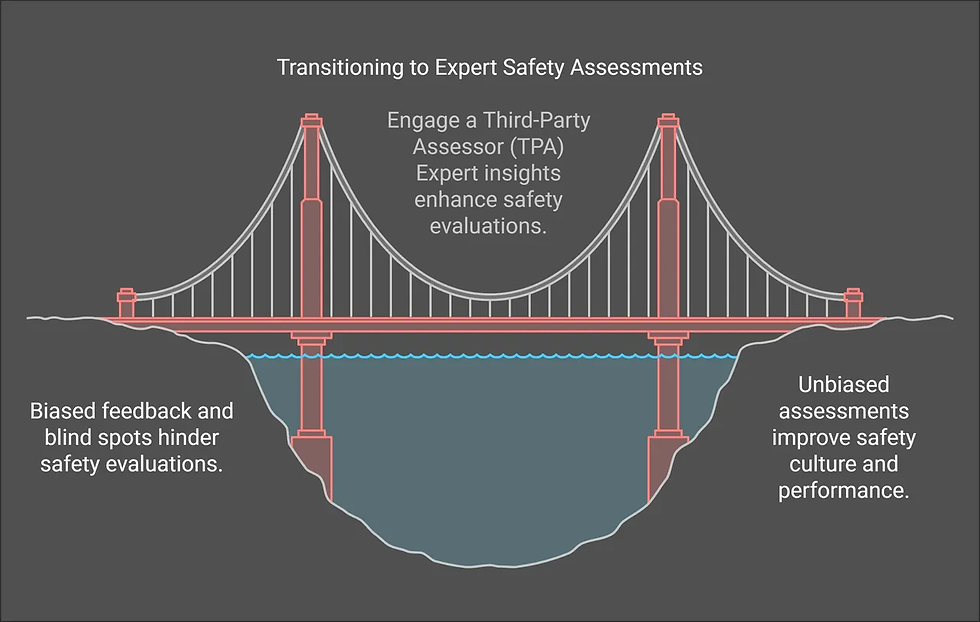Why You Need a Third-Party Safety Survey
- Reyka Ravenwood
- Feb 24
- 4 min read
Updated: Apr 9


—Even If You Have an In-House HSE Team; and you're the most Clint Eastwood Field HSE Professional out there.
Safety First? Prove It. 🚧🦺
Every company claims to prioritize safety. But when was the last time you put that to the test? 🔍 Third-Party Agency (TPA) Safety Surveys aren’t just another box to check—they're a game-changer for uncovering hidden risks, improving safety culture, and proving compliance before an incident forces your hand.
Sure, you might think, "We already have an in-house HSE team—why do we need an external audit?" The answer is simple: bias, blind spots, and benchmarking. Even the best internal teams can struggle with objectivity, miss key insights, or lack access to industry-wide performance metrics.
In today's fast-paced industrial landscape, maintaining a robust Health, Safety, and Environment (HSE) culture is paramount. While internal HSE teams play a crucial role in upholding safety standards, the integration of Third-Party Agency (TPA) safety surveys can offer an unbiased perspective that is often unattainable from within the organization.
🚨 Here’s the truth: If employees don’t feel safe giving honest feedback—or if leadership isn’t getting the full picture—your safety program might not be as strong as you think. 🚨

Hidden Risks of In-House Safety Surveys 🚨
Relying only on internal assessments can create gaps in your safety program. Here’s why:
❌ People hold back – Employees may not be fully honest when giving feedback to internal teams, fearing repercussions or judgment. Internal surveys are often influenced by existing relationships and hierarchies, leading to biased results.
❌ You don’t know what you don’t know– Internal teams, no matter how skilled, might have blind spots that a fresh set of expert eyes can catch.
❌ No industry benchmarks – Without external data, you have no real way to compare your performance against industry best practices.
❌ Time & resource drain – Conducting a truly effective safety survey in-house requires significanttime, effort, and expertise.
🚀 A TPA eliminates these risks, providing an unbiased, expert-driven safety assessment.
Engaging a TPA to conduct safety surveys brings an external, impartial viewpoint, essential for an accurate assessment of an organization's safety culture. They also bring compelling evidence to Operations if you've been trying to lead them to water about some changes you've been begging to implement.

What to Expect: Third-Party Safety Survey
A professional TPA service should deliver:
✅ Unbiased, confidential assessments– Employees feel comfortable sharing real safety concerns. An external assessment can lend greater credibility to the findings, fostering trust among employees and stakeholders.
✅ Industry benchmarking – See how your safety performance compares to competitors and best-in-class organizations with advanced and highly specific tools and methodologies that most In House HSE Professionals don’t have access to, especially if they are Field HSE.
✅ Data-driven insights – Get clear, actionable recommendations based on hard facts, not assumptions.
✅ Customized reports & dashboards – Visualize your safety strengths and weaknesses at a glance.
✅ Strategic improvement plans – Not just “what’s wrong,” but how to fix it with expert-backed action plans.

The TPA Safety Survey Process 🔄
So, how does it work? Here’s what you can expect from a well-structured TPA survey:
1️⃣ Project Planning (1 Week) – Define objectives, logistics, and customize the survey to fit your operations.
2️⃣ Survey Deployment (2 Weeks) – Employees complete truly anonymoussurveys, (online or paper).
3️⃣ Data Collection (4 Weeks) – Gather responses and ensure high participation.
4️⃣ Analysis & Benchmarking (4-6 Weeks) – Experts review data, compare against industry standards, and generate reports.
5️⃣ Results & Action Planning (Ongoing) – Work with HSE leadership to implement real changes based on findings of identified gaps.
6️⃣ Monitor & Improve (Ongoing)– Track improvements and repeat assessments for continuous safety culture growth. Regular review of progress and necessary adjustments of safety programs is what turns them into a living process rather than just a document.

The Bottom Line: Safety is an Investment, Not an Expense 💰
Every injury prevented saves money, lives, and reputations. A TPA survey isn’t just about compliance—it’s about building a workplace where safety is second nature. 🏗️⚠️

🔥 Don’t wait for a near-miss or serious incident to find out where your safety program stands. 🔥 Stay informed and continue to prioritize safety excellence.
⁉️ What are your thoughts? Have you ever had a Third-Party Survey Done? Drop a comment below!
Stay Connected
📰 Subscribe to our blog to stay updated on industry insights, best practices, and practical HSE strategies!
🕵️ Become a Member for more discussions on safety surveys.
☕ Buy Me a Coffee – If you found this article valuable, consider supporting my work! Your contributions help me continue sharing free industry knowledge.
Is your company struggling with this? Book a complimentary meeting with us and lets see what solutions are available for you.

Are you a HR, HSE or QRC Professional that's navigating these challenges in your Career? Book a complimentary Meet & Greet and let us help you get out of the weeds. You don't have to be a lone island!


$50
Product Title
Product Details goes here with the simple product description and more information can be seen by clicking the see more button. Product Details goes here with the simple product description and more information can be seen by clicking the see more button

$50
Product Title
Product Details goes here with the simple product description and more information can be seen by clicking the see more button. Product Details goes here with the simple product description and more information can be seen by clicking the see more button.

$50
Product Title
Product Details goes here with the simple product description and more information can be seen by clicking the see more button. Product Details goes here with the simple product description and more information can be seen by clicking the see more button.





Comments